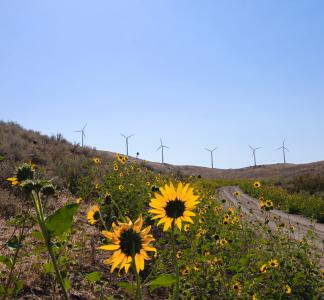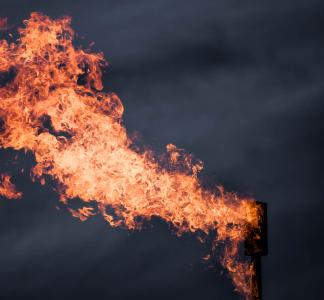It’s time to harness the potential of responsible renewable energy on public land

Flipping the switch at Switch Station 1 and 2 in the Dry Lake Solar Energy Zone, Nevada
Alex Daue, TWS
Report: responsible wind, solar, geothermal on public lands can provide both economic and environmental benefits
Renewable energy is here to stay. U.S. wind and solar energy capacity has more than quadrupled in the last decade, and clean options are increasingly muscling out both retiring coal-fired generation and aging gas plants. All that is good news for a planet already beset by the consequences of fossil fuel-driven climate change.
But we have a lot more work to do if we want to cut greenhouse-gas emissions enough to avoid the worst effects of the climate crisis--and not much time to do it.
The U.S. should be making serious investments in energy conservation and efficiency, rooftop and community-scale solar, repowering old mines and contaminated sites with renewable energy, and repurposing fallowed agricultural fields with solar energy.
Another obvious place to ramp up clean energy projects and phase out fossil fuel development- carefully chosen sites on public lands.
Currently, less than 5 percent of total U.S. solar, wind and geothermal energy capacity comes from projects on public lands. But according to our recent report, these shared spaces have enormous potential The key is to make smart choices about project locations to limit negative environmental impacts:
- Incentivize development in priority, lower-impact areas
- Avoid development in key wildlife habitat, wildlands and areas rich with cultural resources (and take steps to protect those places)
- Require mitigation to offset unavoidable impacts
READ MORE: Key economic benefits of renewable energy on public lands
The report finds renewable energy on public lands is already generating billions of dollars in capital investment; creating hundreds of millions of dollars in federal, state and local revenue; and supporting thousands of jobs.
And there’s a lot more we can be doing. With policies that fund key federal programs and ensure renewable energy construction doesn’t happen in sensitive wildland areas, this type of development can help drive the national transformation that will be required to achieve a sustainable energy future. Though progress on renewable energy on public lands has slowed drastically in recent years, we can achieve these goals through continued investment in a smart and responsible approach to planning and development.
Highlights from the report:
- In 2019, utility-scale solar, wind, and geothermal projects operating on public lands had atotal generation capacity sufficient to power more than two million homes
- Rent and royalty payments from renewable energy development on public lands have contributed over $660 million to federal, state, and local governments since 1982
- Capital costs for building renewable energy projects on public lands have added $13 billion to the economysince 1996
- Renewable energy projects on public lands have created more than 12,000 construction jobs and more than 1,700 operations and maintenance jobs
- Through 2019, the solar projects operating on public lands have resulted in over 11 million tons of avoided CO2emissions,equivalent to taking over 2.4 million passenger vehicles off the road for one year
- A prime example of public land’s renewable energy potential is in Nevada, where the Bureau of Land Management (BLM) oversees 67 percent of the state. Dry Lake Solar Energy Zone, outside Las Vegas, is considered a model of responsible clean energy developmentthat limits and offsets impacts to sensitive habitat
The bottom line: The untapped renewable energy potential of US public lands offers an immediate opportunity for the US federal government to start building a new sustainable energy infrastructure – but we must take a smart, responsible approach.
Nevada emerging as renewable energy leader on public lands
The state of Nevada has emerged as a leader on renewable energy and is highlighted in the report.
A dry, sunny state, Nevada is considered the highest solar-energy potential state in the U.S. It also has significant geothermal energy potential. The state benefits from a growing market for renewable energy from utilities and major electricity users. The majority of the state is federally managed public lands, providing excellent opportunities to expand responsible renewable energy development, while protecting important wildlands and wildlife habitat.
Nevada is already enjoying some of the benefits of renewable energy development on public lands. It’s estimated that more than 4,000 construction jobs have already been created by solar, wind and geothermal projects operating on public lands in the state, as well as over 600 long-term operations and maintenance jobs.
The state of Nevada has worked hard to become a leader in renewable energy, with key successes coming from projects built on public lands
The Dry Lake Solar Energy Zone, about 20 miles outside of Las Vegas, is a prime example of the state’s efforts. Carefully sited in an already extensively developed area, it limits negative impact on the environment. Required investments in wildlife habitat preservation in the region also help offset impacts from development in the zone. So far, solar projects built on the Dry Lake parcels have the generation capacity to power approximately 46,000 homes—averting greenhouse gas emissions that are the equivalent of taking almost 52,000 cars off the road each year.
“The state of Nevada has worked hard to become a leader in renewable energy, and this report underscores the benefits from projects built on public lands to-date and the opportunity for growth,” said David Bobzien, Director of the Nevada Governor’s Office of Energy. “To build on our success and support Nevada’s clean energy economy, we need to work together to find the most suitable development locations and connect up needed transmission. In addition to finding lower-impact sites on public lands, we should also invest in the untapped renewable energy potential that closed mining lands provide.”
How we can build on the progress we’ve made
What are Nevada’s lessons for working towards that balance between renewable energy development and conservation on public lands?“Nevada is blessed with both abundant renewable energy resources and incredible open spaces that are prized for their wildlife habitat, recreation opportunities and natural beauty,” said Bradley Crowell, Director of Nevada’s Department of Conservation and Natural Resources. “This report highlights how smart, coordinated planning can facilitate energy development in lower-impact locations while maximizing Nevada's renewable energy potential and helping us achieve our ambitious clean energy and climate goals."
Across the southwestern US, the Bureau of Land Management has already selected some Designated Leasing Areas (DLAs)— like the Dry Lake Solar Energy Zone, these are places that contain strong resources for renewable energy, such as wind or sunshine, while being close to transmission lines and situated on land where development will not heavily impact habitat or wildlands. These DLAs could be home to hundreds of new solar and wind projects, but this will require commitment from the Bureau of Land Management, states and others to ensure development is prioritized within DLAs and that other areas important for conservation and cultural resources are protected.
Our report lists several recommended actions to drive responsible renewable energy development on public lands in the U.S.:
- Fully fund renewable energy programs at agencies like the Bureau of Land Management. These programs are critical to ensuring our public lands remain a key part of transitioning to a clean energy future.
- Prioritize efficient permitting in existing lower-impact Designated Leasing Areas. We must focus development in places that contain strong resources for renewable energy, such as wind or sunshine, while being close to transmission lines and situated on land where development will not heavily impact habitat or wildlands.
- Plan ahead in key states like Nevada. The Bureau of Land Management and other federal and state agencies must also work together to identify new priority development areas and needed transmission upgrades in key states such as Nevada while protecting key wildlands and wildlife habitat from development. A proactive approach and close coordination among these state and federal agencies are crucial for facilitating additional responsible renewable energy and transmission development.
- Pass legislation to encourage responsible renewable energy development such as the Public Land Renewable Energy Development Act (PLREDA). If passed, this legislation would promote responsible development of solar, wind, and geothermal energy resources on public lands in places with high energy potential and lower impacts on wildlife and habitat.
- Repower old mines and contaminated sites. By facilitating the redevelopment of old mines, landfills, and other contaminated sites with solar, wind, and geothermal energy, federal and state agencies and Congress can increase renewable energy development while reducing pressure on undeveloped “greenfield” sites.
- Focus on equity. Officials musttake steps to help ensure that the economic benefits of renewable energy development are equitably shared. This means including rural communities with limited economic opportunities and communities that are currently dependent on fossil fuel production and will need help diversifying their economies.
READ MORE: A smart approach to renewable energy development can further boost our economy while preserving special places
Your questions answered: Where should we develop renewable energy?
BLM Oregon
New report highlights the renewable energy potential of US public lands
Mason Cummings
A blind spot in the plan to reduce emissions is slowing progress in the fight against climate change
Mason Cummings, The Wilderness Society



